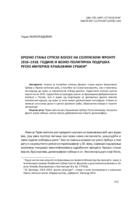3. Radovi iz zbornika
-

-
Бројно стање српске војске на Солунском фронту 1916-1918. године и војно-политичка подршка Руске империје Краљевини Србији
-
Чланак је посвећен питању бројног стања војске Краљевине Србије у Првом светском рату, а посебно на Солунском фронту, као и тумачењу последица до којих су претрпљени губици довели. Недостатак попуне српске војске после 1915. године био је пресудан разлог за формирање Добровољачког корпуса у Русији, али и један од подстицаја за доношење других важних политичких одлука, од којих су неке имале далекосежне последице. Чланак је написан на основу руске и српске архивске грађе, објављених извора и стручне литературе., The article discusses the number of the troops of the Kingdom of Serbia in
the First World War, as well as military and political consequences of its vast
casualties. It has been ascertained that there was a great number of
contradictory and incorrect figures, as well as inconsistent and tendentious
explanation throughout the literature on the subject. However, certain shift
in research has been noted, especially in the latest demographic studies.
Despite its drawbacks, the literature offers the basic frame within which it is
possible to make certain corrections in order to sharpen the image. The image
has been built by systematizing, comparing, organizing and multiple checking
of the data from the published sources, which have been supplemented with
less known or unknown data from the Russian and Serbian archives. The
article is comprised of several parts:
1) The introduction offers the review of the subject in literature. It is
followed by the analysis of the number of Serb soldiers who were evacuated
to Greece. It has been concluded that there was a total of 155,000, but also
that the Serb army had between 20,000 and 21,000 losses, from the arrival at
Corfu since the return to Serbia (16,000 dead and about 4,000 captured and
missing). Besides, a large number of soldiers were in rehabilitation centers
and hospitals in Africa and on non-combat duties at Corfu, Thessaloniki,
France, Switzerland and elsewhere. In certain periods, there were 10,000 or even more people at Corfu and in Bizerte alone. 2) The attention is paid to the number and structure of the Serbian army on the Salonika front. Significant variation in the number of soldiers was shown: from 128,000 “by list” and 116,000 “on the spot” in the summer of 1916, over 130,000 “by list” and 94,000 “on the spot” in the spring of 1917, to 142,000 “by list” and 111,000 “on the spot” at the end of 1918. The important factors were often poor health condition and elderly age of the
soldiers. Moreover, the Serbs had no shifts in positions, nor did they have regular replacements of the troops such as the allied troops, and it all badly influenced their morale. The number of Serb rifles, from about 60,000 upon the arrival at the Salonica front in 1916, dropped to just 26,000 effective rifles at the beginning of 1918, which had held about 60 kilometers of the front.
Бројно стање српске војске на Солунском фронту 1916–1918. године и војно-политичка подршка Руске империје Краљевини Србији 3) The lack of a replacement of the Serbian troops after 1915 was the main reason for the formation of a Serbian volunteer corps in Russia. It was comprised of Austro-Hungarian prisoners-of-war and attempted to gather
people among Serbian, Croatian and Slovenian emigrants. Furthermore, Serbian citizens, fleeing from the Austro-Hungarian and Bulgarian armies or captured by their allies were also mobilized. The people from the liberated territory were mobilized. Despite all the efforts, and expected 100,000 volunteers, only 21,000 were gathered. A total of 18,000 of them arrived at
the Salonica Front, and 15,000 were present “on the spot” at the time of its breakthrough. 4) Before the Salonika offensive, the divisions were strengthened in number and quality, mainly by influx of volunteers. The power of the Serbian army was considerably elevated by the high increase of artillery and automatic weapons. The entire army counted about 142,000, while the forces “on the spot” had about 80,000 officers and soldiers of all divisions. The infantry that made the breakthrough numbered 63,000 people. 5) Instead of the conclusion, the previous findings have been summarized and the reliability of certain data, assertions and interpretations published in the literature is assessed. It has been pointed out to the numbers and the
quality of the army as a crucial circumstance for making important political decisions, some with far-reaching consequences. The demographic indicators for the population of Serbia and other parts of Serb-populated areas have been compared and their reliability has been estimated. It has noted that, despite the exaggerations of some authors, the losses of Serbia and the
Serbian people were so great that the demographic consequences of the First World War have been felt for the next hundred years., Published, Šifra projekta: 177016, Рад је настао као резултат истраживања на пројекту Министарства просвете, науке и технолошког развоја Републике Србије Српско друштво у југословенској држави у 20. веку: Између демократије и диктатуре (Ев. бр. 177016).
